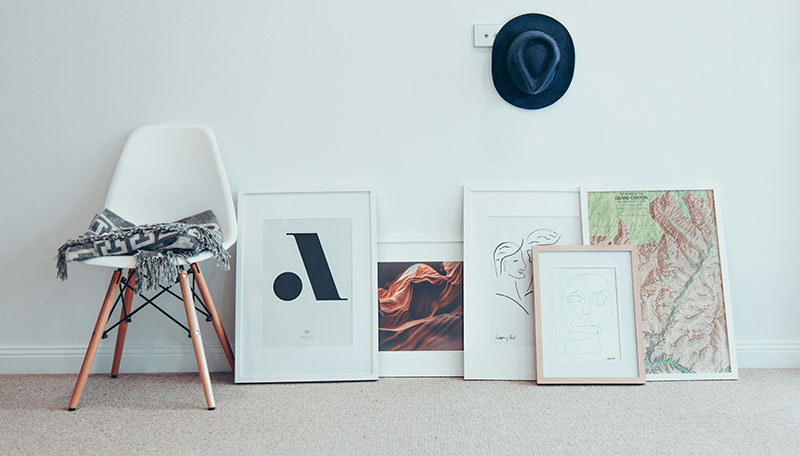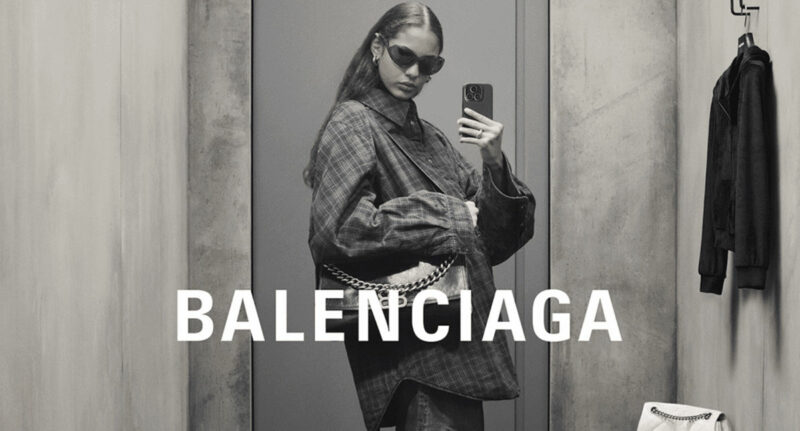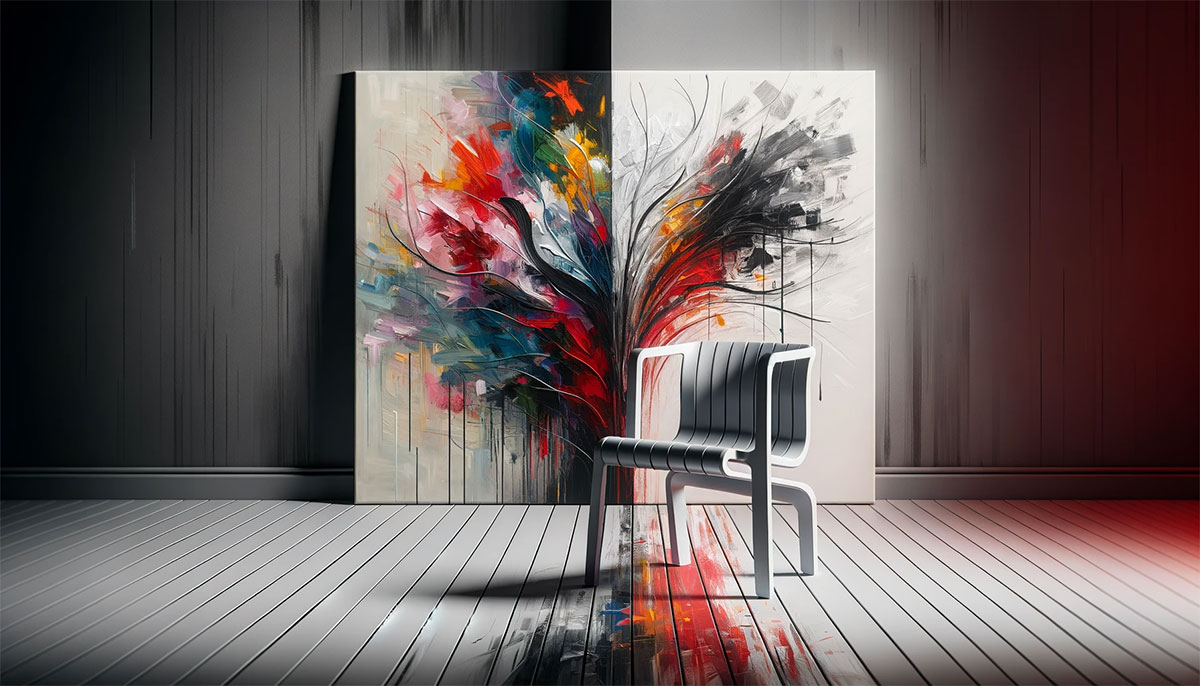Redefining Norms: Postmodern Graphic Design

Dive headlong into a universe where tradition takes a backseat, and unruly creativity grabs the wheel. Postmodern graphic design isn’t just a style; it’s an exuberant rebellion against the clean-cut uniformity of yesteryear’s visuals. Here, form no longer slavishly follows function — it dances around it, sometimes with a cheeky wink.
In the thicket of Swiss Style and Bauhaus sensibilities, a new lingo of design has surfaced. It’s maximalist, it’s edgy, and it doesn’t shy away from a cultural pastiche.
As we peel back layers of deconstructed layouts and David Carson’s typographic ingenuity, you’ll discover a realm where design conventions are questioned, and visual communication is reinvented with audacity.
By the close of this revelation-packed read, your design toolkit will brim with insights on weaving postmodern strategies into your creative repertoire.
Expect to navigate through the vivid evolutions of visual language, ride the waves of innovation, and decode the cultural theory underpinning this poignant graphic design chapter.
What is Postmodern Graphic Design?
Postmodern graphic design is a visually eclectic movement that emerged as a reaction to the strict rules of modernism. It embraces playfulness, irony, and a mix of styles and materials, often incorporating contradictory typefaces, vibrant colors, and a blend of high and low culture to challenge conventional aesthetics.
Philosophical Underpinnings and Influences
Contrast with Modernism
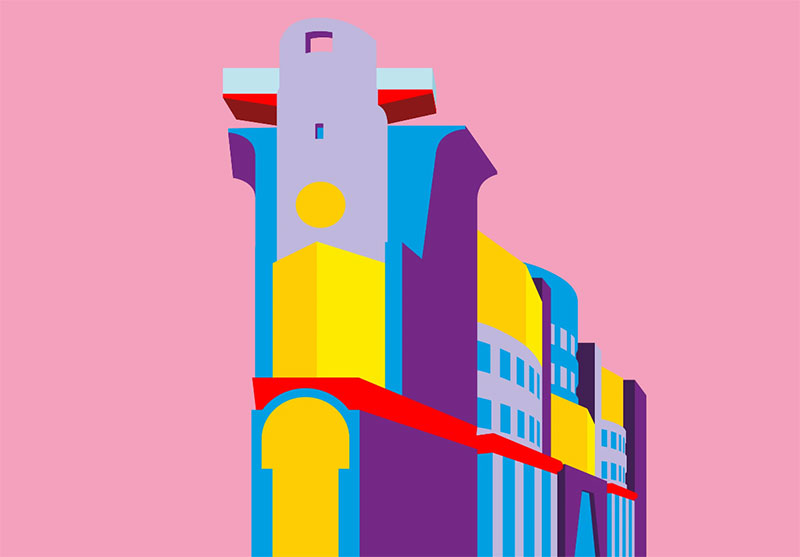
Imagine a world of design where everything is neat, orderly, and makes sense. That’s modernism for you. It’s like a perfectly organized bookshelf. Now, enter postmodern graphic design.
It’s like someone took that bookshelf and turned it upside down. Suddenly, there’s a mix of old and new, clear and obscure, serious and playful. It’s not just a style; it’s a whole new way of thinking.
Postmodernism steps away from the utopian ideals of modernism. Where modernism was all about clarity and simplicity, postmodern graphic design embraces complexity and chaos.
It’s like choosing a wild, vibrant garden over a manicured lawn. Modernism dreamed of a perfect world; postmodernism looks at the world as it is, warts and all, and finds beauty there.
Cultural and Political Influences
Now, let’s talk influences. Ever heard of the punk movement? It wasn’t just about loud music and mohawks. Punk rocked the world of design too.
It brought an attitude of rebellion and DIY aesthetics that left a permanent mark on postmodern graphic design. This wasn’t design from a fancy studio; it was raw, real, and in your face.
Then there’s youth culture and subcultures. These aren’t just groups of young people doing their thing. They’re hotbeds of creativity and innovation.
They took the traditional ideas of beauty and function in design and threw them out the window. In their place, they brought in a mix of styles, bold colors, and a touch of irony.
Think of it as the design equivalent of a music festival where every genre is playing at once.
In this section, we dive deep into these influences. How did they shape the world of postmodern graphic design?
What made them tick? It’s a journey through the heart and soul of a movement that changed how we see the world around us.
Characteristics of Postmodern Graphic Design
Design Elements and Techniques

Alright, let’s dive into the world of postmodern graphic design. Picture this: You’re walking through an art gallery, and each piece is more unpredictable than the last.
That’s the essence of postmodern design. It’s a wild, eclectic mix that’s hard to pin down but totally captivating.
First off, we’ve got collage. Think of it as a visual DJ, mixing and remixing images and styles. It’s not just cutting and pasting; it’s about creating a whole new vibe from existing pieces.
Then, there’s distortion. You know those funhouse mirrors at carnivals? Imagine that, but for design.
It’s about bending and twisting images to create something surreal and eye-catching.
And the colors, oh, the colors! They’re like a neon sign at midnight – bright, bold, and impossible to ignore.
Postmodern design isn’t shy about splashing vibrant colors across the canvas.
It’s like a party for your eyes.
Now, let’s talk typography. We’re not just sticking to the classics here. Abstract typography is the name of the game.
Letters become more than just letters; they’re shapes, they’re art. They twist, they turn, they dance. Mix that with some mixed media, and you’ve got a recipe for something truly unique.
Design Philosophy
Here’s the thing about postmodern graphic design: it’s not just about how it looks; it’s about what it stands for. This style is all about breaking the rules.
Remember all that stuff they taught in art school? Postmodern designers took one look at that and said, “Nope, we’re doing it our way.”
This is design with an attitude. It’s about questioning everything – the norms, the standards, the ‘shoulds’ and ‘shouldn’ts’.
And the result?
A design style that’s as diverse and varied as the designers themselves.
There’s a big focus on pluralism here. It’s like a design buffet with a bit of everything.
You’ve got influences from all over the world, all coming together to create something new and unexpected.
And anti-formalism?
That’s just a fancy way of saying that postmodern design is all about freedom. Freedom to experiment, to play, to create without boundaries.
Pioneers and Notable Practitioners
Key Figures in Postmodern Design
When you think postmodern graphic design, you’re basically stepping into a hall of fame of creativity. These are the trailblazers who didn’t just follow trends; they set them.
First up, Jamie Reid. This guy is like the punk rock star of design. Remember the Sex Pistols’ album covers? That was all him.
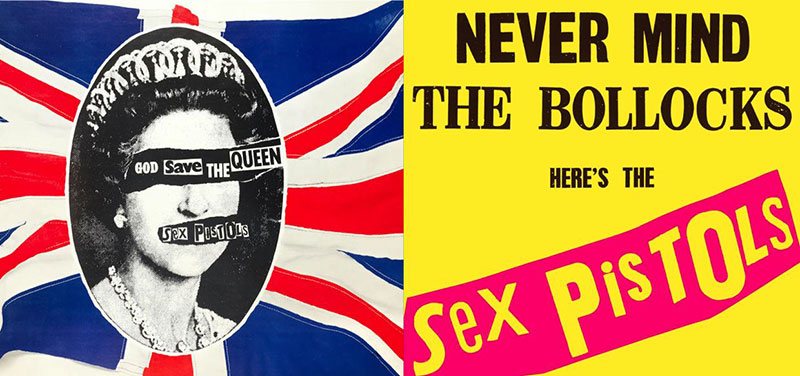
Raw, edgy, and in-your-face, Reid’s work perfectly captures the spirit of rebellion that defines postmodernism.
Next, Wolfgang Weingart. Think of him as the mad scientist of typography. Weingart took the rulebook of typography and, well, threw it out the window.
His work is all about experimentation and breaking the mold, pushing the boundaries of how text can be used in design.
April Greiman is another name you gotta know. She’s like a digital wizard, blending technology and art in ways that were unheard of at the time.
Her work is a kaleidoscope of digital imagery, breaking away from the traditional grid layouts and exploring the digital landscape.
And then there’s David Carson. Surf dude turned design guru. His work on Ray Gun magazine?
Legendary.
Carson’s style is chaotic, unconventional, and utterly captivating.
He’s the guy who showed us that when it comes to design, sometimes breaking the rules is the best way to communicate.
Influence of Design Groups
But it’s not just individuals shaking things up. Groups like Studio Alchymia and Memphis rocked the boat too.
Studio Alchymia? They’re like the avant-garde rebels of the furniture world. They took everyday objects and turned them into something extraordinary.
It’s not just a chair or a lamp; it’s a statement piece. Their influence on postmodern graphic design is all about challenging perceptions and embracing the unconventional.
Memphis, on the other hand, is like a pop art explosion in the design world. Bright colors, bold patterns, and a whole lot of fun.
They took the seriousness out of design and replaced it with a sense of playfulness and whimsy.
Postmodern Design in Practice
Graphic Design and Typography

Let’s talk real-world stuff. How does postmodern graphic design actually show up in our day-to-day? It’s like opening a treasure chest of creativity and letting it spill over into everything visual.
Graphic design? It’s everywhere. In the ads you see, the websites you scroll through, the magazines you flip. Postmodern design shook up the norm.
It’s like designers decided to throw out the rulebook and play jazz with visuals. They started messing with layouts, making them jump off the page.
Typography got a whole new look too. Instead of just being about readable text, it became an art form. It’s like each letter got a personality, you know?
And this isn’t just about making things look pretty. It’s about grabbing attention, making a statement. It’s design with a voice.
Impact on Media and Communication
Ever watched a music video and thought, “Man, that’s cool”? Chances are, you’ve seen postmodern graphic design in action.
It’s in those flashy, unpredictable music videos, in the bold and quirky ads, even in the way movies and TV shows look.
It’s not just about looking different; it’s about thinking different.
These designs don’t just sit there; they speak to you. They might be telling you to buy something, sure, but they’re also telling a story.
The New Wave? That’s a classic example. It’s like a visual remix of what came before – a bit of old, a bit of new, all mixed up to create something totally fresh.
Criticism and Reception
Controversies and Criticisms
Okay, let’s get real for a sec. Postmodern graphic design isn’t everyone’s cup of tea. It’s like Marmite; you either love it or you hate it. And boy, does it have its fair share of critics.
Some folks look at postmodern design and say, “That’s just a bunch of chaos.” They see it as unoriginal, just ripping off old styles and mashing them together.
Like a DJ sampling tracks but not making any new music. There’s a vibe among some critics that it’s more about style than substance, more flash than function.
Then there’s the whole commercialization debate. Some say postmodern design sold out, got too cozy with the ad world. It’s like the rebel that ended up in a suit and tie, working for The Man.
Decline and Legacy
Every trend has its sunset, and postmodern graphic design is no exception. By the time the ’90s rolled around, the buzz started to fade. It’s like when your favorite indie band goes mainstream, and suddenly they’re not as cool anymore.
But here’s the thing: the legacy of postmodern design is huge. It opened doors, broke down walls, and showed us that design can be a playground, not just a set of rules.
Even now, you can see its fingerprints all over the place. In the ads we see, the websites we visit, the magazines we read. It’s like the ghost of postmodern design is still haunting the halls of creativity.
FAQ On Postmodern Graphic Design
What Exactly is Postmodern Graphic Design?
Postmodern graphic design shatters the ‘form follows function’ mantra. It’s a creative revolt that mashes up different styles, time periods, and cultural influences into a single piece.
Think bold and ironic, with a mishmash of typefaces and colors that demand a double-take.
How Does Postmodern Design Differ From Modernist Design?
Modernist design is like a clean, minimalist chessboard, while postmodern design is more like a kaleidoscope.
Postmodernism doesn’t play by the rules; it mixes narratives, plays with pastiche, and defies the order that modernism adores. It’s design with a twist, unwilling to be pigeonholed.
Can you Name Pioneering Designers in the Postmodern Movement?
Sure can! Think trailblazers like Paula Scher, who injected life into typography. Or, imagine David Carson turning magazine design on its head with “Ray Gun.”
These masterminds embraced the chaotic pulse of postmodern design, each crafting a legacy that would rip up the rule book.
What Role Does Typography Play in Postmodern Graphic Design?
Typography in this realm isn’t just about readability; it’s a lead actor in the design drama. With disjointed layouts and whimsical font pairings, type becomes an expressive beast.
It’s not just seen—it’s felt, and it quite literally speaks volumes beyond the words themselves.
Why is Pop Culture Influential in Postmodern Design?
Pop culture fuels postmodern design like gasoline to a flamethrower. It sparks designs that resonate on a more familiar level, weaving in kitsch, trends, and everyday symbols.
It’s an endless buffet of inspiration, serving up a visual feast that’s relatable and, at times, nostalgically saturated.
How has Postmodern Design Influenced Today’s Digital Graphics?
Today’s digital graphics owe a nod to postmodernism’s bold spirit. From the vibrant chaos of web design to striking, rule-breaking app interfaces, the essence of postmodernism lingers.
It paved the way for the digital collage aesthetic and a playfulness that now dominates screens worldwide.
What are the Key Characteristics of Postmodern Graphic Design?
If postmodern graphic design was a party, it’d be notorious. You’d have loud colors clinking glasses with irony, pastiche schmoozing with retro influences, and text and image play spicing up the dance floor.
It’s a maximalist gathering where order is out, and expressive vibrancy reigns supreme.
How Does Postmodern Design Intersect with Consumer Culture?
It crashes straight through the front door. Postmodern design mirrors our consumer world with its eclectic mix, imprinting brands into our psyche.
It’s Manhattan billboards, quirky product packaging, and in-your-face ad campaigns that use shock, juxtaposition, and familiarity to leave a memorable mark.
Is Postmodern Graphic Design Still Relevant Today?
Absolutely. Postmodernism’s DNA is woven into the fabric of contemporary design. It taught us to experiment, to speak louder, and to fold in diverse cultural threads into our work.
From the latest zines to innovative branding, postmodern design is that rebel ancestor whose genes keep popping up.
How Can You Incorporate Postmodern Elements into Your Design Work?
Start by channeling your inner rule-breaker. Mash up those old design handbooks with eclectic aesthetics and digital collage effects.
Borrow from history, stir in some avant-garde typography, and don’t be afraid to merge mediums. It’s about creating a visual language that’s uniquely yours yet unmistakably postmodern in flavor.
Conclusion
Wrapping our heads around postmodern graphic design is like trying to catch a feather in a breeze. It’s wild, it’s elusive, but sure is invigorating.
We’ve journeyed through a landscape where rules got bent and sometimes tossed out the window. Every turn on this path was a surprise—an escape from predictability.
- Typography became a playground, where David Carson is king.
- Retro influence mingled with deconstructivism, all while trends and pop culture made surprising cameos.
- We saw how, far from being a static, bygone era, postmodern design principles live on, with digital graphics and multimedia approaches drawing from its well.
So, we’ve reached that moment where the curtain falls—but the influence of postmodern design? That’s just as alive as ever, fueling innovation, sparking conversations, and challenging creators to push boundaries and redefine what’s visually possible.
Bold? Sometimes controversial? Always impactful. That’s the postmodern design legacy.
If you liked this article about postmodern graphic design, you should check out this article about what is color theory.
There are also similar articles discussing visual hierarchy, Swiss design, graphic design movements, and Bauhaus graphic design.
And let’s not forget about articles on Brutalist graphic design, grid systems in graphic design, Gestalt principles of design, and the golden ratio in design.
- The Kirin Logo History, Colors, Font, And Meaning - 13 May 2024
- The Benefits Of Print on Demand - 13 May 2024
- Earthly Delight: Rich Brown Color Palettes - 13 May 2024



